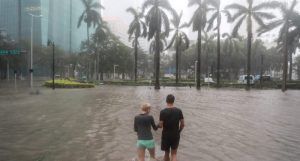
Flooding in the Brickell neighborhood as Hurricane Irma passes Miami, Florida, U.S. September 10, 2017.
Credit: Reuters/Stephen Yang
When the Aztecs founded Tenochtitlán in 1325, they built it on a large island on Lake Texcoco. Its eventual 200,000-plus inhabitants relied on canals, levees, dikes, floating gardens, aqueducts and bridges for defense, transportation, flood control, drinking water and food. After the Spaniards conquered the city in 1521, they drained the lake and built Mexico City over it.
The now-sprawling metropolis, with 100 times the number of inhabitants as Tenochtitlán at its peak, is fascinating, with lively culture, complex history and diverse architecture. It’s also a mess. Water shortages, water contamination and wastewater issues add to the complications of crime, poverty and pollution. Drained and drying aquifers are causing the city to sink—almost 10 meters over the past century.
“Conquering” nature has long been the western way. Our hubris, and often our religious ideologies, have led us to believe we are above nature and have a right to subdue and control it. We let our technical abilities […]











Brilliant. Thank you for posting.
Exactly.